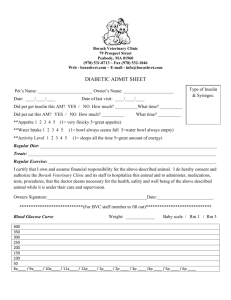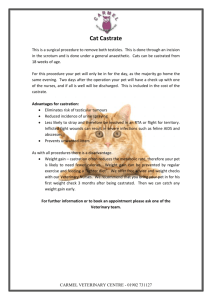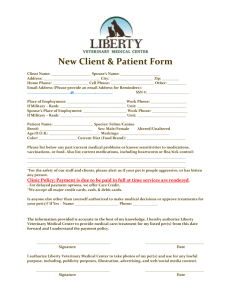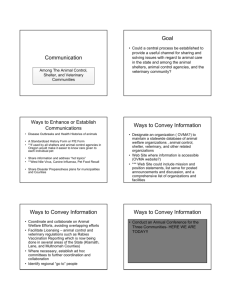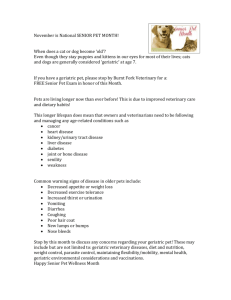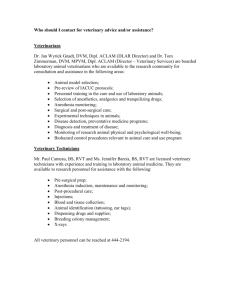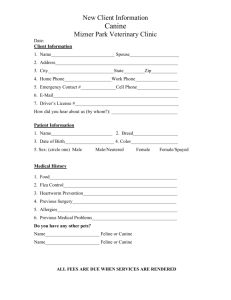North Country Gazette, NY 04-12-07
advertisement
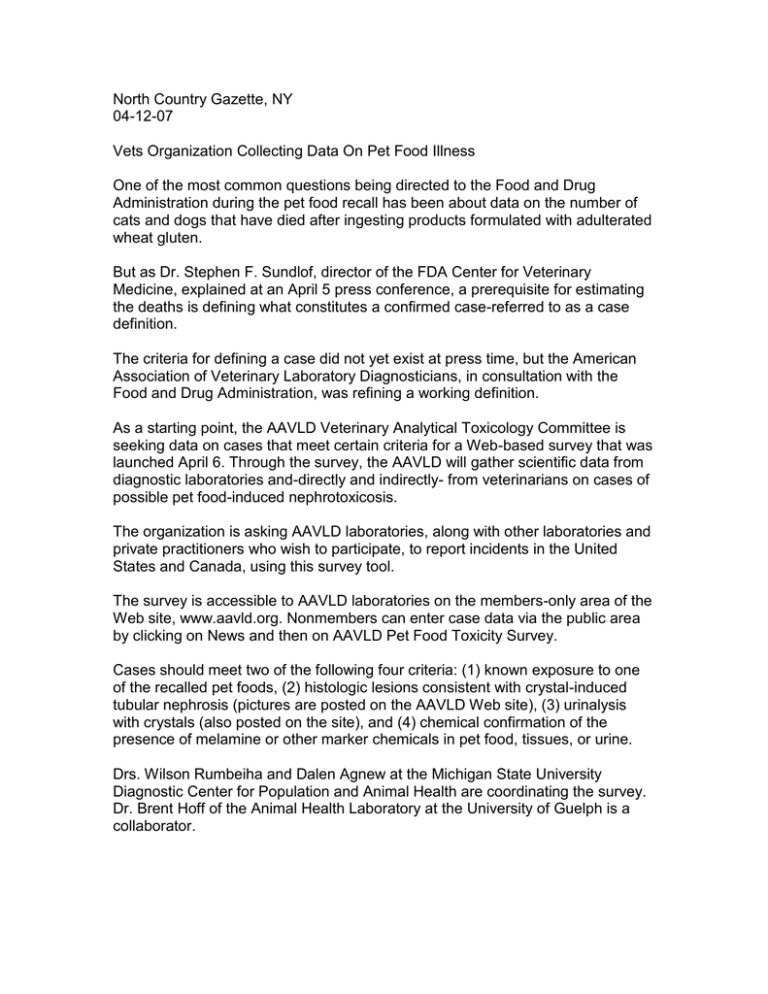
North Country Gazette, NY 04-12-07 Vets Organization Collecting Data On Pet Food Illness One of the most common questions being directed to the Food and Drug Administration during the pet food recall has been about data on the number of cats and dogs that have died after ingesting products formulated with adulterated wheat gluten. But as Dr. Stephen F. Sundlof, director of the FDA Center for Veterinary Medicine, explained at an April 5 press conference, a prerequisite for estimating the deaths is defining what constitutes a confirmed case-referred to as a case definition. The criteria for defining a case did not yet exist at press time, but the American Association of Veterinary Laboratory Diagnosticians, in consultation with the Food and Drug Administration, was refining a working definition. As a starting point, the AAVLD Veterinary Analytical Toxicology Committee is seeking data on cases that meet certain criteria for a Web-based survey that was launched April 6. Through the survey, the AAVLD will gather scientific data from diagnostic laboratories and-directly and indirectly- from veterinarians on cases of possible pet food-induced nephrotoxicosis. The organization is asking AAVLD laboratories, along with other laboratories and private practitioners who wish to participate, to report incidents in the United States and Canada, using this survey tool. The survey is accessible to AAVLD laboratories on the members-only area of the Web site, www.aavld.org. Nonmembers can enter case data via the public area by clicking on News and then on AAVLD Pet Food Toxicity Survey. Cases should meet two of the following four criteria: (1) known exposure to one of the recalled pet foods, (2) histologic lesions consistent with crystal-induced tubular nephrosis (pictures are posted on the AAVLD Web site), (3) urinalysis with crystals (also posted on the site), and (4) chemical confirmation of the presence of melamine or other marker chemicals in pet food, tissues, or urine. Drs. Wilson Rumbeiha and Dalen Agnew at the Michigan State University Diagnostic Center for Population and Animal Health are coordinating the survey. Dr. Brent Hoff of the Animal Health Laboratory at the University of Guelph is a collaborator. In a post-survey follow-up, pathologists will review cases in which association with adulterated pet food is questionable, including those meeting the least number of criteria. Dr. Barbara Powers, AAVLD president and director of the Colorado State University Veterinary Diagnostic Laboratory, said that the survey goal is to distinguish true cases of nephropathy unique to this recall, hopefully resulting in a set of criteria defining a true case. Other survey objectives are to characterize the spectrum of lesions; the temporal and geographic distributions of the suspected intoxications; the species, breeds, and ages of affected animals; and when possible, the brands, lot numbers, and UPC numbers of pet food involved in the toxic exposure, and results of chemical analyses. The data will be made available to the FDA for its investigations and will form the basis for a retrospective study to be presented at the AAVLD meeting in October. Veterinarians who want to submit relevant samples can go to www.aavld.org and click on Accreditation to access a list of AAVLD-accredited veterinary diagnostic laboratories. For other laboratories, Dr. Claire Andreasen, chair of the Department of Veterinary Pathology at Iowa State University, is hosting the AAVLD survey on the American College of Veterinary Pathologists' Web site, www.acvp.org. The three best options for veterinarians who suspect a pet food-related death or illness, Dr. Andreasen said, are to contact a state veterinary diagnostic laboratory, a veterinary teaching hospital, or the veterinary laboratory with which they have a professional relationship. She urges veterinarians to inquire about the laboratory's protocol for submission of samples. "Some laboratories accept the whole animal, and some will just do tissues, so it's important to call the laboratory they use, and they'll direct them appropriately," she said. Dr. Powers encourages practitioners to submit a full complement of tissues for pathology and analytic chemistry analyses. A full complement of formalin-fixed tissues should be submitted for histologic evaluation after an animal is necropsied. Although kidney is the main organ of interest, it is the bare minimum. Similarly, a full complement of fresh tissues from dead animals, or urine and serum samples from live animals, should be collected and frozen for future analytic chemistry analyses. Any recalled product that is brought to a veterinary clinic should be collected and frozen. Thorough notes on these cases should be kept in patient medical records. It is important that veterinarians adhere to the record-keeping requirements of their state veterinary practice act, including those for record retention. Veterinarians can also contact the FDA consumer complaint officer in their state with files and necropsy results for cases that involve renal failure in a pet after the owner fed it food that has been recalled. The officers are listed at www.fda.gov/opacom/backgrounders/complain.html. The FDA Emergency Operations Center is disseminating this incoming information to scientists and inspection teams. To avoid double reporting, veterinarians who report cases to the FDA should let the agency know if they have reported the same ones on the AAVLD survey, and vice versa. For a complete list of the products involved in the recall of adulterated pet food, see http://www.avma.org/aa/menufoodsrecall/products.asp 4-12-07

